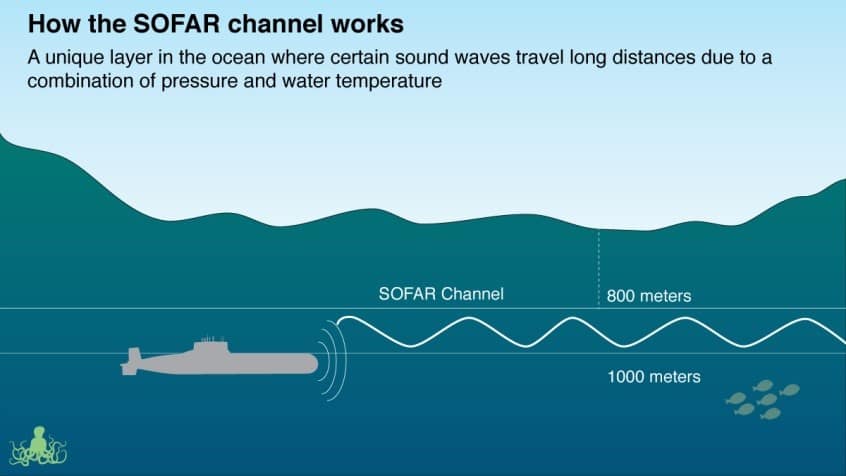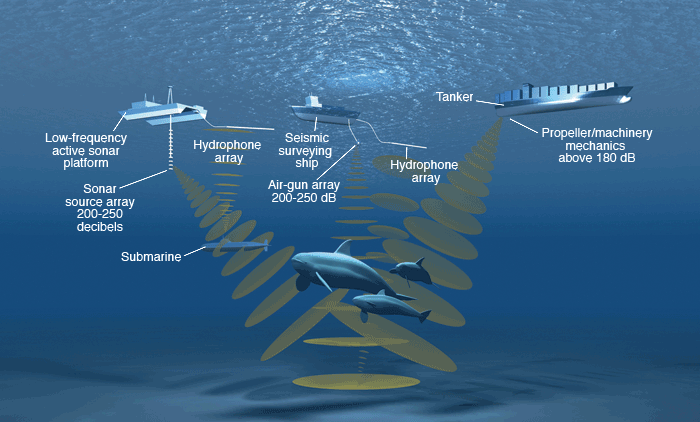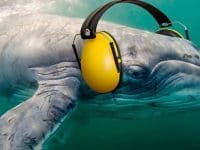Echolocation, Can You Hear Me Now?
A sound is defined as vibrations that travel through air, water, or another medium that can be heard when they reach an ear of a person or animal.
By: Shelby Schmeltzle, Education Program Coordinator

NOAA (2017)
Sound in Water
A sound is defined as vibrations that travel through air, water, or another medium that can be heard when they reach an ear of a person or animal. Sounds travel in a similar wave pattern in almost every medium whether it be gas, liquid, or solid. Even though sound moves in a similar pattern in all mediums, the levels and traveling speed can vary greatly depending on what medium the sound waves are traveling through. Sounds move much faster in water than in air, and can usually travel over much longer distances as well. The distance a certain sound can travel in the ocean depends greatly on the temperature and pressure of the water the sound is traveling in. The sound waves are refracted up and down in the water column depending on the pressure and temperature the sound waves are exposed to. The area in the ocean where sound waves can travel the farthest by being refracted up and down is known as the SOFAR Channel (NOAA 2017). In this channel, sound waves can travel over hundreds and thousands of miles without losing a lot of energy. The sound is extremely important to most animals, including whales and dolphins. It is used for hunting, navigating, and communicating in their environment.


Figure 1: Illustrates the relationship between sound velocity, temperature, and pressure in the ocean (Knave 2006). Figure 2: Illustrates how the SOFAR channel in the ocean works, how it is able to refract soundwaves and allow them to travel for thousands of kilometers (Bookman 2015).
What is echolocation?
Echolocation, also called biosonar, is a type of biological sonar system that is used by many animals for locating prey and navigating in their environment. It is when an animal emits a sound into their environment and waits to listen to the echoes of that sound as it refracts off of different objects in their environment. Animals using this can get an idea of the location of prey and makeup of their environment in areas that they cannot see. The animals that use this technique are usually located in environments that make it hard to visually located prey and navigate, like bats, whales, and dolphins. Toothed whales are an example of a group of animals that use echolocation for hunting and navigating. It is extremely beneficial for toothed whales and dolphins to use echolocation in the ocean because sound travels five times faster in water than it does air. Echolocation allows the whales and dolphins to get a good idea of the layout of their environment and also locate prey that can be kilometers away. Also, it is a useful adaptation in the water because most of these animals are doing their hunting in dark and turbid (water filled with sediment) water, making it almost impossible to visually locate their prey. Echolocation makes it easy to locate and hunt prey that could not be visually seen.

Figure 3: Illustrates how echolocation works in bats and toothed whales (Cockey 2013).
Adaptations for echolocation
Dolphins and other toothed whales have very well developed sensory systems that have evolved over hundreds and thousands of years to allow them to use echolocation. The exact location where the sound is produced in the dolphin or whale is not yet known or well understood. One theory is that they produce various high-frequency sounds by moving air between the sinuses and air spaces in their heads (NOAA). They send these sounds out into their environment and listen for the echoes they receive back when the sound is refracted off of objects. The echoes are received by an oil filled area in the lower jaw and then conducted to the middle ear (NOAA). The picture below illustrates the believed physical mechanism for echolocation in dolphins. Even though the physical mechanism for echolocation is not well understood yet, we do know it is a very sensitive tool. It is believed that some wild dolphins rely on echolocation oversight in different conditions. There was a study on dolphins in public aquariums that focused on studying the sensitivity of echolocation. They found that dolphins in aquariums were able to distinguish between a B-B pellet and a kernel of corn (both less than 0.5in in diameter) at a distance of 50ft (15.2m) away (NOAA). We have observed Bottlenose Dolphins in Cape May, New Jersey using their echolocation to locate the local species of fish around Cape May Point and along the beaches of Wildwood.

Figure 4: the physical mechanism for echolocation in dolphins (http://www2.hawaii.edu).
Sound Pollution in our oceans
Over the past couple of decades; the amount of noise in our oceans has greatly increased, making noise pollution a major problem in our oceans. Noise pollution is generally defined as regular exposure to elevated sound levels that may lead to adverse effects in humans or other living organisms (Environmental 2017). There has been a drastic increase in the amount of noise being put into our oceans from motor boats, shipping traffic, jet skis, sonar, and oil rigs (Noise Pollution). It is easy to ignore this growing problem in our oceans because it is not as easily seen or noticed like other pollution such as marine debris, but it is just as deadly. Whales and dolphins rely on sound to communicate, hunt, and visualize their environment over a large distance. The increases in artificial or man-made sounds are making it harder and harder each passing year for the whales and dolphins to communicate with each other. This increase in sound can cause whales to become separated from their pod, or deviate off of their normal migration pattern (Tyack and Clark 1998). The direct impact of these artificial noises on marine life is not yet well understood and is an area of ongoing research. It is believed that the increase in noise pollution in our oceans is causing the increase in accidental beaching we see in different whale populations. The whales become disoriented due to the increased amount of noise in the oceans and end up beaching themselves accidentally, but it has yet to be scientifically proven. Scientists are currently studying the levels and frequencies of noise pollution that start to negatively affect marine life. Dr. Sylvia Earle summarized the problem of noise pollution the best; she stated that "undersea noise pollution is like the death of a thousand cuts. Each sound in itself may not be a matter of critical concern, but taken all together, the noise from shipping, seismic surveys, and military activity is creating a totally different environment than existed even 50 years ago. That high level of noise is bound to have a hard, sweeping impact on life in the sea" (Natural Resources Defense Council, 1999).

Figure 5: Illustrates ocean noise pollution in different forms (Gruber 2018).
How you can help!
There are a lot of things an individual can do in their everyday lives to help lower the amount of noise pollution in our oceans. First and most important is to buy local products. Try to buy produce, meat, and other products that are manufactured close to home, that doesn’t require shipping overseas. By doing this we can greatly decrease the amount of commercial shipping traffic in our oceans which will cut down noise pollution as well as other types of pollution including marine debris. If you or someone you know owns a boat, make sure you keep in clean and the engine in working order and insulated, this will greatly reduce the amount of sound emitted underwater. Lastly, be sure to pick your water recreation areas carefully, when jet skiing or boating make sure you do so properly and avoid protected marine areas. It is a difficult job to try to regulate the noises that are put into our oceans but we can all do these small things and make a huge difference.
We take great pride in the maintenance of our vessels Cape May Whale Watcher, Atlantis, and Miss Chris. The vessels propellers are kept in perfect balance by being reconditioned each year at haul out. The vessels engines are EPA Tier II and Tier III rated engines to provide the highest efficiency and less noise. When we view marine mammals like Humpback Whales and Bottlenose Dolphins, our multi-engine vessels are maneuvered on one or two engines at most to reduce noise and disruption in the water. We also shut down the vessel's active sonar or fish finder to further reduce the noise we are making. This company-wide policy seems to increase our sightings.

References
Bookman, Todd. 2015. Eavesdropping On The Ocean. Wilbur. Retrieved from: http://www.wbur.org/hereandnow/2015/02/12/eavesdropping-on-the-ocean.
Cockey, Christine. 2013. Echolocation. Science Fun. Retrieved from: https://mistralmtn.blogspot.com/2013/09/echolocation.html
Echolocation: Communication of Marine Mammals, Bats, and Humans. Retrieved from: http://www2.hawaii.edu/~zinner/101/students/YvetteEcholocation/echolocation.html
Environmental Pollution Centers. 2017. What Is Noise Pollution? Retrieved from: https://www.environmentalpollutioncenters.org/noise-pollution/
Gruber, E. 2018. Ocean Noise Pollution Harms Marine Life From The Smallest To The Largest. Awesome Ocean. Retrieved from: http://awesomeocean.com/conservation/noise-pollution-harms-marine-life/
Knave, T. 2006. Aloha Dump. Retrieved from: http://alohadump.blogspot.com/2006/05/and-knowing-is-half-battle.html
Natural Resources Defense Council. 2003. Press Release entitled Federal Court Restricts Global Deployment of Navy Sonar. San Francisco: www.nrcd.org
NOAA. 2017. How far does sound travel in the ocean? National Ocean Service. Retrieved from: https://oceanservice.noaa.gov/facts/sound.html
NOAA. Marine Mammal Laboratory. NOAA Fisheries. Retrieved from: https://www.afsc.noaa.gov/nmml/education/cetaceans/cetaceaechol.php
Noise Pollution. Sea the Sea. Retrieved from: http://see-the-sea.org/topics/pollution/noise/noise_pollution.htm
Tyack and Clark 1998. Playback of low-frequency sound to grey whales migrating past the central Californian Coast. Department of Biology, Woods Hole Oceanographic Institute, Woods Hole, Massachusetts






